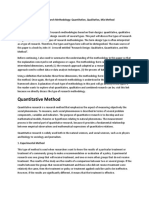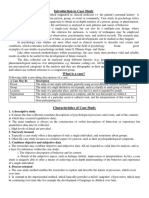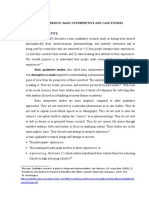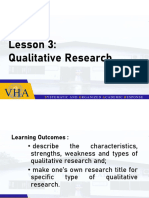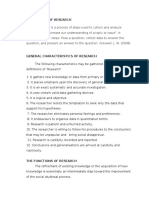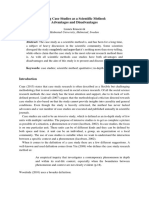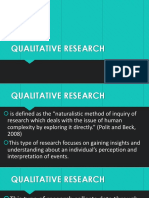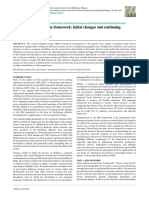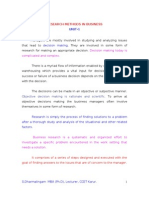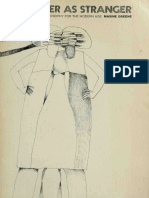Case Study
Case Study
Uploaded by
Anand SwainCopyright:
Available Formats
Case Study
Case Study
Uploaded by
Anand SwainCopyright
Available Formats
Share this document
Did you find this document useful?
Is this content inappropriate?
Copyright:
Available Formats
Case Study
Case Study
Uploaded by
Anand SwainCopyright:
Available Formats
See discussions, stats, and author profiles for this publication at: https://www.researchgate.
net/publication/344780835
Case Study Method
Chapter · October 2020
CITATIONS READS
0 39,636
1 author:
Ksh Beliya Luxmi Devi
Manipur University
9 PUBLICATIONS 3 CITATIONS
SEE PROFILE
All content following this page was uploaded by Ksh Beliya Luxmi Devi on 21 October 2020.
The user has requested enhancement of the downloaded file.
Paper No. : 13 Research Methods and Fieldwork
Module : 18 Case Study Method
Development Team
Principal Investigator Prof. Anup Kumar Kapoor
Department of Anthropology, University of Delhi
Dr. P. Venkatramana
Paper Coordinator
Faculty of Anthropology, School of Social Sciences,
IGNOU, Delhi
Ms. Beliyaluxmi Devi
Content Writer Department of Anthropology
Manipur University, Manipur – 795003
Dr. Rashmi Sinha
Content Reviewer Faculty of Anthropology, School of Social Sciences,
IGNOU, Delhi
1
Case Study Method
Anthropology
Description of Module
Subject Name Anthropology
Paper Name Research Methods and Fieldwork
Module Name/Title Case Study Method
Module Id 18
Contents:
1. Introduction
2. Case Study
2.1 Definition
2.2 Characteristics
2.3 Difference between Case study Vs Case history
3 Techniques used for case studies
4 Sources of data for case studies
5 Types of case Studies
6 Advantage and limitation
Summary
Learning Objectives:
To learn what is case study and distinction from case history; identify the application of case
study;
To discuss how to plan case study; and
To understand the advantage and limitation of case study
Case Study Method
Anthropology
1. Introduction
Among the various methods of data collection, case study is certainly one popular form of qualitative
analysis involving careful and complete observation of a case. A case is a social unit with a deviant
behavior, and may be an event, problem, process, activity, programme, of a social unit. The unit may
be a person, a family, an institution, a cultural group, a community or even an entire society (Kothari,
2014). But it is a bounded system that has the boundaries of the case. Case Study therefore is an
intensive investigation of the particular unit under consideration. It is extensively used in psychology,
education, sociology, anthropology, economics and political science. It aims at obtaining a complete
and detailed account of a social phenomenon or a social event of a social unit. In case study, data can
be collected from multiple sources by using any qualitative method of data collection like interviews,
observation and it may also include documents, artifacts etc. Case study method is a type of data
collection that goes in depth understanding rather than breadth. Case study can be descriptive as we
observe and write in description as well as it can also be an exploratory that is we wrote what was said.
Pierre Guillaume Frederic Le Play (1855), a mathematician and natural scientist, is considered as the
founder of case study method as he used it for the first time in his publication Les Ouvriers Europeens.
2. Case Study
2.1 Definitions of Case Study Methods
Case study has been defined differently by different scholars from time to time. Some of them are
presented below.
1. Young, P.V. (1984): Case study is a comprehensive study of a social unit, be it a person, a
group of persons, an institute, a community or a family.
2. Groode and Hatt (1953): It is a method of exploring and analyzing the life of a social unit
3. Cooley, C.H. (2007): Case study depends our perception and gives clear insight into life
directory.
4. Bogardus, E. S. (1925): The method of examining specially and in detail a given situation
Case Study Method
Anthropology
5. Robson C. (1993): A strategy for doing research which involves an empirical investigation of a
particular contemporary phenomenon within its real life context using multiple sources of
evidence.
So critical analysis of these definitions, reveal that case study is a method of minute and detail
study of a situation concerning a social unit in an intensive and comprehensive manner in
order to understand the personal as well as hidden dimensions of human life.
2.2 Characteristics of Case Study
The main characteristics of the case study are (www.studylecturenotes.com):
A descriptive study:
a. The data collected constitute descriptions of psychological processes and events, and of the
contexts in which they occurred.
b. The main emphasis is always on the construction of verbal descriptions of behavior or
experience but rarely quantitative data may be collected. In short case study is more of a
qualitative method rather than quantitative method.
c. High levels of detail are provided.
d. The behavior pattern of the concerned unit is studied directly wherein efforts are made to
know the mutual inter-relationship of causal factors.
Narrowly focused:
a. Typically a case study offers a complete and comprehensive description of all facets of a
social unit, be it a single individual or may be a social group.
b. Often the case study focuses on a limited aspect of a person, such as their
psychopathological symptoms.
Combines objective and subjective data:
Researchers may combine objective and subjective data. Both the data are regarded as valid
data for analysis. It enables case study to achieved in-depth understanding of the behavior
and experience of a single individual.
Case Study Method
Anthropology
Process-oriented:
a. The case study method enables the researcher to explore and describe the nature of
processes, which occur over time.
b. In contrast to the experimental method, which basically provides a stilled ‘snapshot’ of
processes, case study continued over time like for example the development of language in
children over time.
2.3. Difference between Case Study and Case History
The Case study method helps retaining the holistic and meaningful characteristics of real life events –
such as individual life cycles, small group behavior, etc. It is like a case history of a patient. As a
patient goes to the doctor with some serious disease, the doctor records the case history. Analysis of
case history helps in the diagnosis of the patient’s illness
(http://www.differencebetween.com/difference-between-case-study-and-vs-case-history).
Although most of us confuse case study and case history to be the same, however, there exists a
difference between these two terms. They are being used in many disciplines and allow the researcher
to be more informative of people, and events. First, let us define the word case study. A case study
refers to a research method where a person, group or an event is being investigated which is used by
researchers whereas a case history, on the other hand, refers to a record of data which contributes to a
case study; usually case history is used by doctors to investigate the patients. This is the main
difference between a case study and case history.
(i) What is a Case Study?
A case study is a research method used to investigate an individual, a group of people, or a particular
phenomenon. The case study has been used in many disciplines especially in social science,
anthropology, sociology, psychology, and political science. A case study allows the researcher to gain
an in-depth understanding of the topic. To conduct a case study, the researcher can use a number of
techniques. For example, observation, interviews, usage of secondary data such as documents, records,
etc. It usually goes on for a longer period because the researcher has to explore the topic deeply.
Case Study Method
Anthropology
The case study method was first used in the clinical medicine so that the doctor has a clear
understanding of the history of the patient. Various methods can be used in a case study for example a
psychologist use observation to observe the individual, use interview method to broaden the
understanding. To create a clear picture of the problem, the questions can be directed not only to the
individual on whom the case study is being conducted but also on those who are related to the
individual. A special feature of case studies is that it produces qualitative data that are rich and
authentic.
(ii) What is a Case History?
Unlike the case study that refers to a method, a case history refers to a record of an individual or even a
group. Case histories are used in many disciplines such as psychology, sociology,
medicine, psychiatry, etc. It consists of all the necessary information of the individual. In medicine, a
case history refers to a specific record that reveals the personal information, medical condition, the
medication that has been used and special conditions of the individual. Having a case history can be
very beneficial in treatment of disease. However, a case history does not necessarily have to be
connected to an individual; it can even be of an event that took place. The case history is a recording
that narrates a sequence of events. Such a narrative allows the researcher to look at an event in
retrospect.
Table 1: Difference between Case Study and Case History
Case Study Case History
1 A case study is a research method used to A case history refers to a record of an
investigate an individual, a group of people individual or even a group.
or a particular phenomenon.
2 Case study method is used by researcher in Case history is used by doctors in medicals
social sciences
3 Different research methodology like A case history can be based only on
interview, questionnaire, schedule, secondary source that can contribute to a case
6
Case Study Method
Anthropology
observation were used history.
4 It is a method in which a number of It is a record of information
techniques can be used for data collection.
3. Techniques used for Case Studies
The techniques of case studies includes –
(i) Observation
It is a systematic data collection approach. Researchers use all of their senses to examine people in
natural settings or naturally occurring situations. Observation of a field setting involves: prolonged
engagement in a setting or social situation.
(ii) Interview
It is questioning and discussing to a person for the purpose of an evaluation or to generate information.
(iii) Secondary Data
Secondary data refers to data that was collected by someone through secondary sources.
(iv) Documents
Any writing that provides information, especially information which is of official in nature.
(v) Records
Anything that provides permanent information which can rely on or providing an evident officially.
Figure 1: Techniques Used for Case Studies
Case Study Method
Anthropology
4. Sources of Data for Case Study
In case study, information may be collected from various sources. Some of the important sources
include:
Life histories
Personal documents
Letters and records
Biographies
Information obtained through interviews
Observation
5. Types of Case Study
The following are the types of case study according to the Graham R Gibbs (2012) -
1. Individual case study: This study was first done by Shaw, Clifford R. (1930). In individual case
study, life of a particular person, his activities and his totalities were accompanied.
2. Set of individual case study: Group of person that practice different culture was studies. As for
instance those lives in rural area and those living in urban area there will different cases between
them.
3. Community studies: In community studies, it may include hundreds of people from a
community that picked upon for some reason.
4. Social Group Studies: Group of people that defined their social position, for example a group of
musician or a group of drugs taker
5. Studies of organizations and institutions: Study for a particular organizations or an institutions
6. Studies of events, roles and relationships: Similar to individual case study but more focus on
events, roles and relationships that involved. For example we can take the role of a housewife.
Case Study Method
Anthropology
Figure 2: Types of Case Study
Identifying a Case Study:
Determine if a case study will answer your research question
Identify the case and find out what type of case study method or technique will be employed
When the researcher makes interpretations, the researcher should be able to learn the meaning
of the case data while interpreting
How to plan a case study?
The following points are required to plan a case study such as -
Conceptual Framework: based on the theory it displays the important features of a case study
and show relationships between features.
Research Questions: Consist of conceptual framework which is consisting of focused and
answerable questions.
Research Design: Plan out of what to include or what not to include before data collection
9
Case Study Method
Anthropology
Methods and Instruments: an appropriate method should be employed to answer the research
question
Analysis of Data and interpretation: Collected information should be analysed using statistical
tools and interpret the findings incorporating the ideas and knowledge gathered during data
collection
6. Advantages and Limitations
6.1 Advantages of Case Study
The following are some of the advantages of case study -
a) It facilitates intensive study and in-depth analysis of a social unit which help in contradicting
established theory.
b) In-depth and comprehensive information are collected through this method which helps in
stimulating new research.
c) It is suitable for collecting data pertaining to sensitive areas of a social phenomenon.
d) It helps to collect details regarding the diverse habits, traits and qualities of the unit under
investigation (Kothari, 2014).
e) The researcher can understand better the social change of different facets of a social unit every
now and then.
f) This study can be a means to understand the past of a social unit because of its emphasis of
historical analysis.
g) The researcher can used any type of methods like interview, questionnaire, documents, self-
reports etc.
h) Case study enables to generalize the knowledge amusing from the information collected.
i) A real personal experience can be recorded which enlighten and reveal the real man’s inner
determined.
j) The data obtained through case study is useful for formulation of hypothesis and preparation of
schedule and questionnaire for such types of study and for further research (Kothari, 2014).
k) It helps in enhancing his/her experience, ability and skill in content analysis of the data.
10
Case Study Method
Anthropology
l) It is useful for therapeutic and administrative purposes, particularly in diagnosis, treatment and
therapy etc.
6.2 Limitations of Case Study
a) Case history records could be open to errors due to faulty selection of case and inaccurate
observation (Kothari, 2014).
b) There are chances of inaccuracy of the data as no uniform and standardized system of recording
case histories has been developed.
c) Data collected from case study usually based on several assumptions which may not be very
realistic at times
d) This method is mainly qualitative rather than quantitative, hence there may be question of
subjectivity.
e) It is very difficult to draw generalizations on the basis of a few cases.
f) Sampling is not possible in case study as this method can be used only in a limited unit.
g) The information collected from case study is incomparable since each informant gives his/her
own opinion. Therefore, replication is not possible.
h) Since this method is fully based on the informant, sometimes the informant himself thinks that
he/she have the full knowledge and the information given by them may include some fake also.
i) The investigator’s bias might distort the quality of the case study (Kothari, 2014).
j) Case Study is time-consuming and costly in certain cases.
k) This method cannot be effectively used in big and complex societies (Kothari, 2014).
Summary
Case study is an important method employed for collection of qualitative data for an in depth, intensive
and comprehensive scientific study of a social unit. This social unit can be an individual, a family, a
community, a group or even an entire society. Case study is quite different from the case history which
focuses on the recording of personal information. Different methods of case study such as individual,
community, social group, organization and events using appropriate techniques (observation,
11
Case Study Method
Anthropology
interview, secondary data like documents and records) are used based on the objectives of the research
problem. The main sources of data in case studies includes life histories, personal documents, letters
and records, biographies, information obtained through interviews and observation. Case studies
facilitate intensive study and in-depth analysis of a social unit contradicting established theory. It helps
in contradicting established theory and stimulating new research. However, difficulties arises in case
studies due to a number of reasons which includes inconsistency in data, not possible to replicate the
findings, interviewing key and right informants, expertise of the investigator, constant monitoring of
interaction between the theoretical issues being studied and collected data, and interpretation of the
data needs to be carefully considered.
12
Case Study Method
Anthropology
View publication stats
You might also like
- Sociology Research MethodDocument5 pagesSociology Research Methodtanishqprajapati532No ratings yet
- Types of Research MethodologyDocument5 pagesTypes of Research Methodologyali muhdor100% (1)
- Culture and The Evolutionary ProcessDocument344 pagesCulture and The Evolutionary ProcessJacob L ChisauskyNo ratings yet
- Five Qualitative Approaches To InquiryDocument8 pagesFive Qualitative Approaches To Inquirypaulus silalahiNo ratings yet
- General Forms of ResearchDocument13 pagesGeneral Forms of ResearchJhay Son Monzour Decatoria100% (2)
- Case StudyDocument13 pagesCase StudySyesha SyeshaNo ratings yet
- 5 Types of Qualitative Research PDFDocument10 pages5 Types of Qualitative Research PDFPeregrin TookNo ratings yet
- 5 Types of Qualitative ResearchDocument10 pages5 Types of Qualitative ResearchPeregrin Took100% (2)
- PR1 Hand Out No. 2Document3 pagesPR1 Hand Out No. 2kyyzelleezapantaaNo ratings yet
- The Kinds of Qualitative Research: Prepared By: Raymond D. AmbasaDocument17 pagesThe Kinds of Qualitative Research: Prepared By: Raymond D. AmbasaJc jhorey MabayambangNo ratings yet
- Practical Research 1 - Q 1 - Mod 2 - Qualitative Research and Its Importance To Daily Life - v5Document26 pagesPractical Research 1 - Q 1 - Mod 2 - Qualitative Research and Its Importance To Daily Life - v5Doreen Khrystel GonzalesNo ratings yet
- Unit 11Document12 pagesUnit 11jsfakir1996No ratings yet
- What Is A Case Study-1Document4 pagesWhat Is A Case Study-1RajinderKumarNo ratings yet
- Women in Bangladesh Civil Service: Mystique of Their DevelopmentDocument13 pagesWomen in Bangladesh Civil Service: Mystique of Their DevelopmentHasina Akter EvaNo ratings yet
- Practical Research I Q3 Module 2Document24 pagesPractical Research I Q3 Module 2Janine MagnayeNo ratings yet
- Unit 3 MSC1Document12 pagesUnit 3 MSC1anu ruhan505No ratings yet
- Qualitative ResearchDocument9 pagesQualitative ResearchLord ListowelNo ratings yet
- 66d2c87f819c2d0012f1606c_##_Research Aptitude 04- Daily ClassnotesDocument10 pages66d2c87f819c2d0012f1606c_##_Research Aptitude 04- Daily Classnotessachin10ecoNo ratings yet
- Pananaliksik Sa BullyingDocument3 pagesPananaliksik Sa BullyingnorhaimamaldizaNo ratings yet
- Midtern PR 1Document20 pagesMidtern PR 1Kristina PabloNo ratings yet
- Qualitative Research Is An Act of Inquiry orDocument26 pagesQualitative Research Is An Act of Inquiry orVince Darwin Gabona100% (2)
- Paper 2Document2 pagesPaper 2Rupesh SurveNo ratings yet
- Unit 13 Introduction Including EthnographyDocument2 pagesUnit 13 Introduction Including EthnographyMr M DNo ratings yet
- Case Study Method HandoutDocument3 pagesCase Study Method HandoutRon RamosNo ratings yet
- Chapter 3.the Case Study MethodDocument5 pagesChapter 3.the Case Study MethodMagix SmithNo ratings yet
- Research Design: Basic Interpretive and Case Studies: Searchdesign PDFDocument7 pagesResearch Design: Basic Interpretive and Case Studies: Searchdesign PDFElfa Maulana0% (1)
- Case StydyDocument60 pagesCase Stydyfarsana molNo ratings yet
- Meaning: The Case Study Method Is A Very Popular Form of Qualitative Analysis and Involves A Careful andDocument3 pagesMeaning: The Case Study Method Is A Very Popular Form of Qualitative Analysis and Involves A Careful andRajani JhaNo ratings yet
- Methods of PsychologyDocument29 pagesMethods of PsychologyAaditya KhannaNo ratings yet
- Practical Research Mod 2Document9 pagesPractical Research Mod 2Markiel Justine Abao DomosmogNo ratings yet
- Att HKRDJafe4Y16-3PEE0uYU997mAA3PU73ec5CZA6IJRwDocument9 pagesAtt HKRDJafe4Y16-3PEE0uYU997mAA3PU73ec5CZA6IJRwKhan TalkNo ratings yet
- Chapter Iii-Methods and Procedures 1Document14 pagesChapter Iii-Methods and Procedures 1Dexter BaretNo ratings yet
- Case Study 4Document3 pagesCase Study 4somya mathurNo ratings yet
- Fakhri FikriDocument4 pagesFakhri FikrifakhriNo ratings yet
- Lesson 3Document33 pagesLesson 3symoncapacilloNo ratings yet
- Qualitative Research Ms IIIDocument41 pagesQualitative Research Ms IIIemamma hashirNo ratings yet
- PRACTICAL-RESEARCH-1_MIDTERMDocument42 pagesPRACTICAL-RESEARCH-1_MIDTERMFaiza GadjaliNo ratings yet
- Crim ResearchDocument10 pagesCrim ResearchARTIAGA RONNELLE A.No ratings yet
- T..... Research Methodology AssignmentDocument10 pagesT..... Research Methodology AssignmenthendrixNo ratings yet
- QualitativeResearch PDFDocument17 pagesQualitativeResearch PDFyuvNo ratings yet
- Practical Research 1: Week 3Document9 pagesPractical Research 1: Week 3Carrie Lhee Bascones BoadoNo ratings yet
- Nature of Inquiry and Research: Some Research Ethics PrinciplesDocument11 pagesNature of Inquiry and Research: Some Research Ethics PrinciplesAlexander QuemadaNo ratings yet
- PR1 M3.1 Types of Research JJAIDocument4 pagesPR1 M3.1 Types of Research JJAIHar VeyNo ratings yet
- JoshuaDocument18 pagesJoshuaKimberly NgNo ratings yet
- Book Review (Final)Document12 pagesBook Review (Final)Jun Rey ParreñoNo ratings yet
- Review Materi-Rizal Rifkiyanto-TBI DDocument7 pagesReview Materi-Rizal Rifkiyanto-TBI DRizal RifkiyantoNo ratings yet
- Research 1 Module4Document26 pagesResearch 1 Module4Christine LopenaNo ratings yet
- Kinds of Qualitative ResearchDocument30 pagesKinds of Qualitative ResearchApril joy DamascoNo ratings yet
- Full Text 01Document11 pagesFull Text 01SoumiaNo ratings yet
- Qualitative Research MethodsDocument16 pagesQualitative Research MethodsAldye XNo ratings yet
- Lesson 9 Types of Qualitative ResearchDocument34 pagesLesson 9 Types of Qualitative ResearchAiza San Pedro Santos100% (1)
- SSED 22 Socio Cultural Chapter 2Document3 pagesSSED 22 Socio Cultural Chapter 2delferroraylaNo ratings yet
- Practical Research 1Document3 pagesPractical Research 1Abi De GuzmanNo ratings yet
- Case Study MethodDocument3 pagesCase Study Methodvermaniharika777No ratings yet
- C5 Qualitative Research Methodology - 18032023Document27 pagesC5 Qualitative Research Methodology - 18032023Nanthakumar SubramanianNo ratings yet
- Module 2 Practical Research 1Document5 pagesModule 2 Practical Research 1Jhon Leonard RubiNo ratings yet
- Case StudyDocument10 pagesCase Studygeetukumari100% (2)
- Practical Research 1Document5 pagesPractical Research 1Kaireen OzNo ratings yet
- Format of Case StudyDocument12 pagesFormat of Case StudyKrishnav sharmaNo ratings yet
- Investigating the Psychological World: Scientific Method in the Behavioral SciencesFrom EverandInvestigating the Psychological World: Scientific Method in the Behavioral SciencesNo ratings yet
- Understanding Culture, Society, and Politics: (UCSP) Week 1Document6 pagesUnderstanding Culture, Society, and Politics: (UCSP) Week 1Joana IrishNo ratings yet
- SHDH1017 Teaching PlanDocument6 pagesSHDH1017 Teaching Plan20141091aNo ratings yet
- A Systematic Review of The Transactional LeadershiDocument5 pagesA Systematic Review of The Transactional LeadershiZarbakhat AzamNo ratings yet
- AP Psychology AAQ Midterm.docx (1)Document3 pagesAP Psychology AAQ Midterm.docx (1)25203No ratings yet
- MCGINNIS Et OSTROM 2005 Social Ecological System FrameworkDocument12 pagesMCGINNIS Et OSTROM 2005 Social Ecological System FrameworkRodolfo WenxuanNo ratings yet
- Lesson 1 UTSDocument3 pagesLesson 1 UTSElla AlogNo ratings yet
- 2008-Harvey Stensaker. Quality CultureDocument17 pages2008-Harvey Stensaker. Quality CultureyasmineNo ratings yet
- Introduction To Educational Sociology Solved MCQ's With PDF Download (Set-1)Document11 pagesIntroduction To Educational Sociology Solved MCQ's With PDF Download (Set-1)nilam thatoiNo ratings yet
- CONNECTORDocument20 pagesCONNECTORJewel AhmedNo ratings yet
- Midterm in SST 203. Teaching Social Studies in The Intermediate Grades DetaroDocument3 pagesMidterm in SST 203. Teaching Social Studies in The Intermediate Grades DetaroRona Liee PelaezNo ratings yet
- (DISS 4) Symbolic Interactionism Students'Document2 pages(DISS 4) Symbolic Interactionism Students'AndreiNo ratings yet
- Chapter 4Document14 pagesChapter 4Maurice ZorillaNo ratings yet
- 1.1. Sustainable Development: Environmental Planning & PracticeDocument7 pages1.1. Sustainable Development: Environmental Planning & Practiceadeel raziNo ratings yet
- Representation of Women in Philippine PRDocument125 pagesRepresentation of Women in Philippine PRraine acryNo ratings yet
- The Axial AgeDocument3 pagesThe Axial AgejiaqichangNo ratings yet
- Decision Making Today Is Complicated and ComplexDocument20 pagesDecision Making Today Is Complicated and ComplexarulsweathaNo ratings yet
- (Caderno Sesc - Videobrasil 12) Vilém Flusser Et Al. - METAFLUXUS-Associação Cultural Videobrasil (2017)Document170 pages(Caderno Sesc - Videobrasil 12) Vilém Flusser Et Al. - METAFLUXUS-Associação Cultural Videobrasil (2017)ankebfNo ratings yet
- Dawodu - 2020 A - Multi-Dimensional - Energy-Based - Analysis - of - NeighDocument23 pagesDawodu - 2020 A - Multi-Dimensional - Energy-Based - Analysis - of - NeighahmadNo ratings yet
- Emotions Vs FeelingsDocument15 pagesEmotions Vs FeelingsbianoerlynmayeNo ratings yet
- Educational Philosophy For Maxine: Modern Age GreeneDocument328 pagesEducational Philosophy For Maxine: Modern Age GreeneVitor MalvaNo ratings yet
- Daily Lesson Plan: School Grade Level Teacher Learning Area Time & Dates QuarterDocument3 pagesDaily Lesson Plan: School Grade Level Teacher Learning Area Time & Dates Quarterrodriguezmarkanthony653No ratings yet
- Critical Discourse Analysis Ma DissertationDocument4 pagesCritical Discourse Analysis Ma DissertationBuyResumePaperCanada100% (1)
- Introducing Anticipation: Roberto PoliDocument407 pagesIntroducing Anticipation: Roberto PoliDaniel PeresNo ratings yet
- CLC Task 13 Nur Lailatul FDocument13 pagesCLC Task 13 Nur Lailatul FNur Lailatul FauziahNo ratings yet
- Comparative Linguistics: Mouats Rania Boumendjel Fatima Boularess Ibtissem Boutaghane AsmaDocument5 pagesComparative Linguistics: Mouats Rania Boumendjel Fatima Boularess Ibtissem Boutaghane Asmachibout mlNo ratings yet
- Energeia Et Entelekheia Chez TheophrasteDocument8 pagesEnergeia Et Entelekheia Chez TheophrastethierryNo ratings yet
- Trees in Vodou: An Arbori-Cultural Exploration: Journal For The Study of Religion Nature and Culture April 2015Document27 pagesTrees in Vodou: An Arbori-Cultural Exploration: Journal For The Study of Religion Nature and Culture April 2015Looppool100% (2)
- Social Science: (1) Previous Year QuestionsDocument29 pagesSocial Science: (1) Previous Year QuestionsDiriglhNo ratings yet
- (The Languages of Asia 16) William McClure - Alexander Vovin - Studies in Japanese and Korean Historical and Theoretical Linguistics and Beyond - Festschrift Presented To John B. Whitman (2018, Brill)Document231 pages(The Languages of Asia 16) William McClure - Alexander Vovin - Studies in Japanese and Korean Historical and Theoretical Linguistics and Beyond - Festschrift Presented To John B. Whitman (2018, Brill)Valerio PiccionelloNo ratings yet

